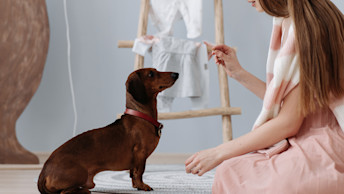July 15, 2022
How to Train Your Dog at Home in a Small Space

Not everyone has the luxury of being able to work with their dog in a big yard or at a spacious dog training school. Especially for city-dwelling dog owners, most of the training needs to happen in spaces of less than 200 sq ft! It might seem impossible to navigate your dog through different skill sets in such a space. However, there are many ways to work with your dogs in very small spaces - here we share some of them.
When should you train?
If you are scheduled to go to a training class at a training center, you will have to show up there at the given time, no matter whether your dog is up for training or not. This is not always ideal for every dog, because just like people they have certain times of the day when they are ready to learn - and other times when they just want to relax. A great advantage of training at home in small spaces is that you can easily adjust your training schedule to your dog’s mood.
If you feel like your dog’s enthusiasm varies a lot from session-to-session, take some notes on when exactly you work with them. You will probably find out that your dog is doing much better at certain times of the day than others. If you are working with them at home, you have the luxury to finetune your training schedule exactly to their “happy times” - you will get a lot more out of your sessions like this.
Brief and frequent
The newer your dog is to training, the more you have to focus on brief training sessions.
The attention span of many young dogs is just one or two minutes. If you train much longer than that, you can cause them to regress in their skills.
Start with short training sessions. For dogs that get distracted very easily, this could even mean a 30 second session. It is much better if your dog can focus 100% for 30 seconds than if you train for 10 minutes and your dog gets distracted and frustrated throughout. However, you should strive to train frequently during the day. How about working for a brief time before work and then again after you come home in the afternoon and before bed? That way, your dog can rehearse the new skills frequently and learn them quickly.
Training ideas
Let’s look at some training ideas for small spaces! You can either train those skills one after the other or switch them up throughout your sessions.
Name game
The Name Game is one of my favorite games to play with dogs that need extra help with focusing. Have your dog in front of you and hold treats in your hand. Feed your dog a few, then drop a treat to the ground. As soon as your dog has picked up the treat, say their name (“Fido!”). They will look up to you in expectation of another treat, and as they’re doing so associate the eye contact with hearing “Fido”. Because there are no competing reinforcers in this game (that means nothing that your dog wants more than your treats), they can be highly successful right from the start, and learn rapidly.
By my side
Many owners struggle with their dog’s leash walking skills while out on a walk. What they do not know however is that great leash walking in fact does not start outside on the road … but at home. If our dogs cannot easily find our side and stay there in a low-distraction environment, then how could they ever do it at a busy park? Your living room or bedroom is a perfect place to start practicing the By my side game. Take some treats and stand next to a wall. Lure your dog between you and the wall and reward from the hand that’s next to the dog. (The wall has the purpose of eliminating wrong options - by standing next to the wall, our dog cannot swing out their hind end and stay straight) Now the dog is in perfect heeling position! Take a step forward and reward again. The more you practice this, the better your dog will become at staying exactly by your side and not dashing out ahead.
Ignoring food
Put a treat on the ground and make sure your dog sees it - then as they go to snatch it up, cover it with your hand. Do not allow your dog to steal the food, but instead wait for them to sit, lie down or take a step back. Then you can uncover the treat and give it to them. This goes directly against the instinct of the dog (which is to just go for it when they see something yummy).
Being able to stand back and wait is impulse control that all dogs need to learn.
As a professional dog trainer, I can tell you that over half of all training problems that I see are due to lack of impulse control. Building impulse control up gradually at home through exercises like this is a great way to set your dog up for good manners.
The bottom line
Only having small spaces available for training won’t keep your dog from making progress - with the right training schedule and ideas, you can really make this work in your favor! Set up frequent and short training sessions. Introducing new skills at home will let your dog be successful right away and lay the foundation for great manners in all places!
For more training tips and advice, visit Spirit Dog Training.



